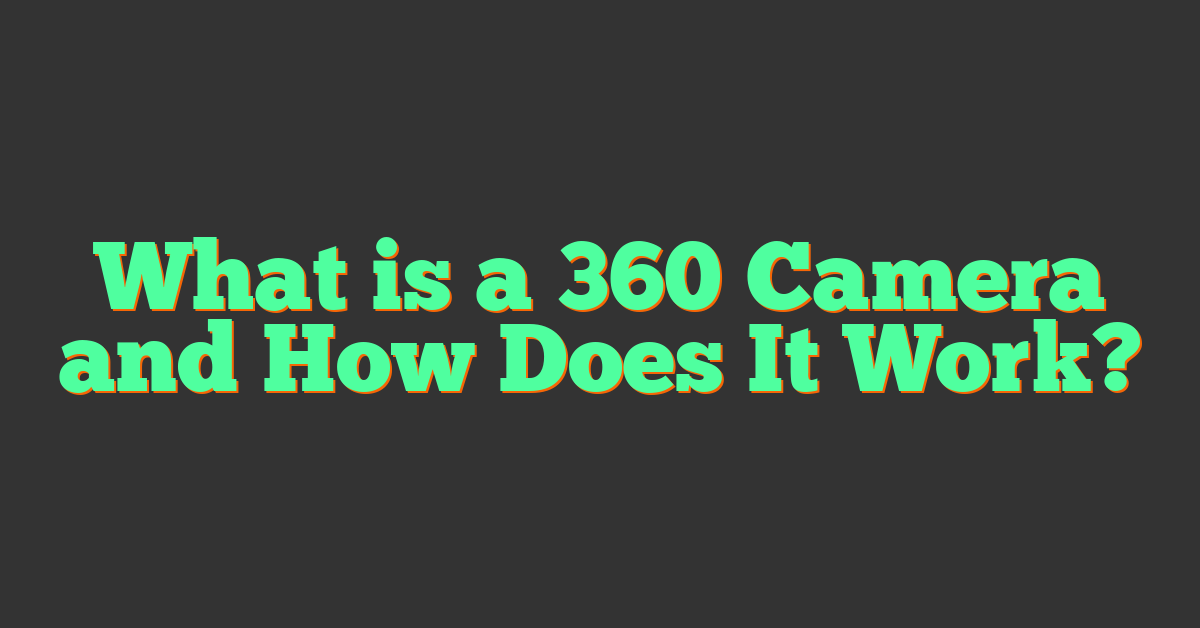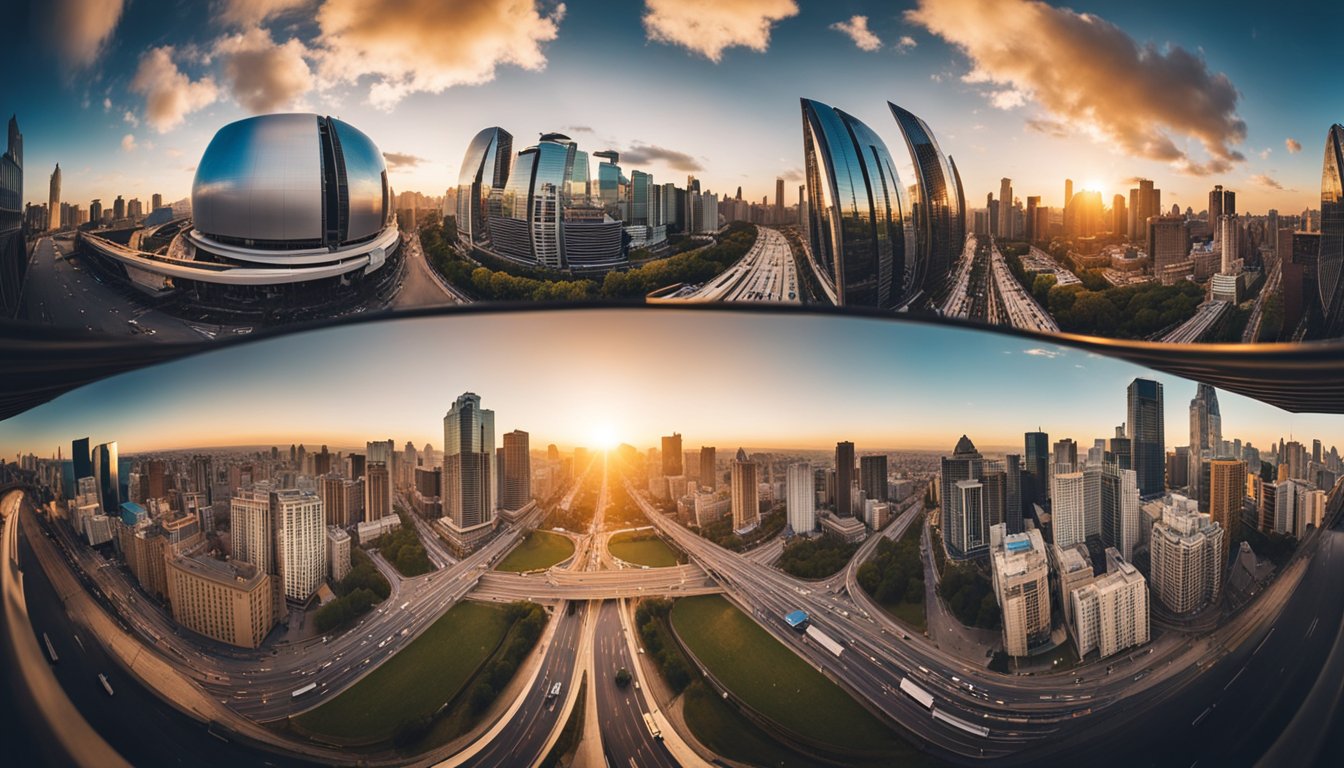If you’re interested in photography or videography, you might have heard of 360 cameras. These cameras are unique in that they capture a full 360-degree view of the world around them. This means that when you take a photo or video with a 360 camera, you’re not limited to just one point of view. Instead, you can capture everything around you, giving your viewers a fully immersive experience.
360 cameras work by using two or more lenses to capture a 360-degree view of everything around them. The camera then stitches these images together into a 360-degree sphere. This allows you to see everything around you in one shot, making it perfect for capturing landscapes, events, and even virtual reality experiences. In this article, we’ll take a closer look at what 360 cameras are, how they work, and some of the key features you should look for when choosing one.
Key Takeaways
- 360 cameras capture a full 360-degree view of the world around them, allowing you to see everything in one shot.
- These cameras use multiple lenses to capture the view and stitch the images together into a 360-degree sphere.
- When choosing a 360 camera, look for key features such as resolution, image stabilization, and compatibility with editing and sharing software.
Understanding 360 Cameras
https://www.youtube.com/watch?v=WtAiEeZiYfs&embed=true
If you’re interested in capturing everything around you, then a 360 camera might be just what you need. These cameras are designed to capture a full 360-degree view of your surroundings, allowing you to create immersive photos and videos that put your audience right in the middle of the action.
Evolution of 360 Cameras
360 cameras have come a long way since their inception. Early models were bulky, expensive, and difficult to use, but today’s cameras are sleek, affordable, and user-friendly. With advancements in technology, 360 cameras have become more accessible to the average consumer, allowing anyone to capture stunning 360-degree images and videos.
How 360 Cameras Work
360 cameras work by using multiple lenses to capture a complete view of your surroundings. These lenses capture images or videos simultaneously, and the camera then stitches these images or videos together to create a seamless 360-degree view. The camera then processes and compresses this data into a single frame or video that can be viewed on a compatible device.
When you take a photo or video with a 360 camera, you’re essentially capturing everything around you in one shot. This means that your audience can look in any direction and see what you saw when you took the photo or video. It’s a truly immersive experience that can be used for a variety of purposes, from personal storytelling to professional marketing.
Whether you’re an amateur photographer or a seasoned professional, a 360 camera can help you capture stunning images and videos that will leave your audience in awe. With their user-friendly design and advanced technology, 360 cameras are the perfect tool for anyone looking to capture the world around them in a whole new way.
Key Features of 360 Cameras
If you’re looking for a camera that can capture everything in every direction, a 360 camera is the way to go. Here are some of the key features you can expect from a 360 camera:
Resolution and Image Quality
360 cameras come in different resolutions, but the most common ones are 5.7K and 4K. The higher the resolution, the sharper and more detailed your images and videos will be. Keep in mind that higher resolution also means larger file sizes, so make sure you have enough storage space.
Stabilization Technology
« What are 360 Cameras: A Beginner’s Guide
How Does a 360 Camera Work on Cars: A Beginner’s Guide »
360 cameras can be prone to shaky footage, but many models have built-in stabilization technology to counteract this. Look for cameras with 6-axis stabilization or electronic image stabilization (EIS) to ensure smooth and steady footage.
Waterproof Capabilities
If you’re planning on taking your 360 camera on water adventures, make sure it’s waterproof. Some models are waterproof out of the box, while others require a separate waterproof case. Look for cameras with at least an IPX7 rating to ensure they can withstand splashes and submersion in water.
Overall, 360 cameras are great for capturing immersive photos and videos that let you relive your experiences in every direction. Whether you’re taking stills or shooting video, make sure you pay attention to the camera’s resolution and video quality, stabilization technology, and waterproof capabilities to ensure you get the best footage possible.
Popular 360 Camera Models
If you’re interested in capturing immersive 360-degree photos and videos, there are several popular 360 camera models to choose from. In this section, we’ll cover two of the most popular brands: Insta360 and GoPro.
Insta360 Series
Insta360 is a leading manufacturer of 360 cameras. One of their most popular models is the Insta360 One R, which features a modular design that allows you to swap out different camera modules depending on your needs. The Insta360 One R is available in several configurations, including a 360-degree camera module and a 4K wide-angle module.
Another popular Insta360 camera is the Insta360 X3, which is designed for action sports and outdoor activities. The X3 features a rugged, waterproof design and can capture 360-degree video at up to 5.7K resolution. It also includes advanced features like FlowState stabilization and TimeShift.
GoPro 360 Cameras
GoPro is another popular brand that offers a range of 360 cameras. One of their most popular models is the GoPro Max, which features dual 180-degree lenses that can capture 360-degree video at up to 5.6K resolution. The Max also includes features like HyperSmooth stabilization and TimeWarp.
Another popular GoPro 360 camera is the GoPro Fusion, which features dual 180-degree lenses and can capture 360-degree video at up to 5.2K resolution. The Fusion also includes features like OverCapture, which allows you to frame your shots after the fact, and TimeShift, which lets you adjust the speed of your footage.
Overall, both Insta360 and GoPro offer a range of high-quality 360 cameras that are perfect for capturing immersive photos and videos. Whether you’re a professional photographer or just looking to capture some fun memories, there’s a 360 camera out there that’s perfect for you.
Using 360 Cameras for Virtual Reality
https://www.youtube.com/watch?v=iK_nfBKsaDk&embed=true
If you’re interested in creating immersive experiences, 360 cameras are a great tool to have in your arsenal. With a 360 camera, you can capture a full 360-degree view of your surroundings, allowing you to create virtual tours, immersive video content, and more.
Creating VR Content
360 cameras are an essential tool for creating VR content. With a 360 camera, you can capture a full 360-degree view of your surroundings, allowing your viewers to feel as if they’re actually there. This makes 360 cameras perfect for creating virtual tours of real estate properties, museums, and other attractions.
When creating VR content with a 360 camera, it’s important to keep a few things in mind. First, you’ll want to make sure you have good lighting. Poor lighting can make your VR content look grainy and unprofessional. Second, you’ll want to make sure you have a stable camera mount. Shaky footage can make your viewers feel nauseous and ruin the immersive experience.
VR Headsets and Viewing
Once you’ve created your VR content, you’ll need a way for your viewers to experience it. This is where VR headsets come in. VR headsets allow your viewers to step inside your VR content and experience it as if they’re actually there.
There are many different VR headsets on the market, ranging from budget-friendly options like Google Cardboard to high-end options like the Oculus Rift. When choosing a VR headset, it’s important to consider factors like comfort, resolution, and compatibility with your device.
Overall, 360 cameras are a powerful tool for creating immersive experiences. Whether you’re creating virtual tours, immersive video content, or something else entirely, a 360 camera can help you take your content to the next level.
Editing and Software Tools
https://www.youtube.com/watch?v=ohLSrwDkxFE&embed=true
If you want to create stunning 360-degree videos, editing and software tools are essential. In this section, we will discuss the best software for 360 video editing and mobile editing apps.
Software for 360 Video Editing
When it comes to editing 360-degree videos, there are several software options available. One of the most popular choices is Adobe Premiere Pro. This software allows you to import 360-degree footage and edit it just like any other video. You can reframe your footage, adjust colors, and add special effects to create a unique look. Other popular options include Final Cut Pro X, CyberLink PowerDirector, and Pinnacle Studio.
When choosing software for 360 video editing, it’s important to look for features that are specific to 360 video. Some of these features include the ability to reframe your footage, adjust the field of view, and add 360-degree titles. You should also look for software that supports the format of your camera.
Mobile Editing Apps
If you want to edit your 360-degree videos on the go, there are several mobile editing apps available. One of the most popular options is the GoPro app, which allows you to edit your footage on your mobile device. You can trim your clips, adjust colors, and add music to create a unique look. Other popular options include V360, Insta360, and Theta+.
When choosing a mobile editing app, it’s important to look for features that are specific to 360 video. Some of these features include the ability to reframe your footage, adjust the field of view, and add 360-degree titles. You should also look for apps that are compatible with the format of your camera.
In conclusion, editing and software tools are essential for creating stunning 360-degree videos. Whether you’re using desktop software or a mobile editing app, make sure to choose software that supports the features you need to create the look you want.
Choosing the Right 360 Camera
https://www.youtube.com/watch?v=5MvtlBYOFHg&embed=true
When it comes to choosing the right 360 camera, there are a few factors you should consider. Whether you’re a professional or a hobbyist, there are options available for every budget and performance level. Here are some things to keep in mind when selecting the perfect 360 camera for your needs.
For Professionals
If you’re a professional looking for the best 360 camera on the market, there are a few top picks to consider. One of the best options is the Insta360 Pro 2, which offers incredible performance and high-end features. It has six lenses that capture 8K resolution footage and can live stream in 4K. It also has advanced stabilization and HDR capabilities, making it a great choice for professionals who need the best of the best.
Another great option is the GoPro MAX, which is a more budget-friendly choice that still offers impressive performance. It has dual lenses that capture 360 footage in 6K resolution and can live stream in 1080p. It also has built-in stabilization and offers a range of shooting modes, making it a versatile option for professionals.
For Hobbyists
If you’re a hobbyist looking for a more budget-friendly option, there are plenty of choices available. One of the best options is the Ricoh Theta V, which is a compact and easy-to-use camera that offers great performance. It has dual lenses that capture 360 footage in 4K resolution and offers advanced features like built-in Wi-Fi and Bluetooth connectivity.
Another great option for hobbyists is the Samsung Gear 360, which is a more affordable choice that still offers impressive performance. It has dual lenses that capture 360 footage in 4K resolution and offers a range of shooting modes, making it a great choice for beginners.
No matter what your needs are, there are plenty of 360 cameras available to choose from. By considering your budget and performance needs, you can find the perfect camera to capture your next adventure in stunning 360-degree footage.
Shooting Techniques for 360 Cameras
https://www.youtube.com/watch?v=RHejHmUZR_U&embed=true
When it comes to shooting with a 360 camera, there are a few things to keep in mind to ensure you capture the best possible footage. Here are some tips to help you get started.
Capturing Spherical Views
One of the biggest advantages of a 360 camera is its ability to capture spherical views. To make the most of this feature, you should experiment with different perspectives. Try placing the camera at different heights and angles to capture unique views.
For example, you could place the camera on the ground to capture a worm’s-eye view, or you could hold it above your head to capture a bird’s-eye view. You can also experiment with different camera movements, such as panning and tilting, to create dynamic shots.
Camera Placement and Movement
Another important aspect of shooting with a 360 camera is camera placement and movement. To create smooth and seamless footage, it’s important to avoid sudden movements or jerky camera motions. Instead, try to move the camera slowly and steadily to create a more natural-looking shot.
You should also experiment with different camera placements. For example, you could attach the camera to an action cam mount to capture footage while you’re on the move, or you could place it on a tripod to capture static shots.
Overall, the key to capturing great footage with a 360 camera is to experiment with different techniques and perspectives. With a little practice, you’ll be able to create stunning, immersive footage that will transport your viewers to a whole new world.
Advanced Features and Accessories
https://www.youtube.com/watch?v=dvQBGev2vbQ&embed=true
If you’re looking to take your 360 camera experience to the next level, you may want to consider some of the advanced features and accessories available.
Modular Cameras and Add-ons
One of the most exciting developments in the world of 360 cameras is the rise of modular cameras and add-ons. These cameras allow you to swap out lenses, sensors, and other components to customize your camera to your specific needs. This means that you can upgrade your camera as new technologies become available, or simply swap out components to suit different shooting situations.
Some popular modular cameras include the Insta360 ONE R and the GoPro MAX. These cameras offer a range of modular accessories, including different lenses, battery packs, and even 3D audio attachments.
Extended Battery and Storage Options
One of the biggest challenges of shooting with a 360 camera is managing battery life and storage. Fortunately, there are a number of accessories available that can help you extend both.
Many 360 cameras support microSD cards, which allow you to expand your storage capacity significantly. You can also look for cameras with built-in SSDs or other high-capacity storage options.
To extend your battery life, you can invest in external battery packs or portable chargers. Some cameras also come with removable batteries, which can be swapped out for fresh ones on the go.
Overall, there are a wide range of accessories and add-ons available that can help you get the most out of your 360 camera. Whether you’re looking to upgrade your camera’s capabilities or simply extend your shooting time, there’s an accessory out there that can help you achieve your goals.
Sharing and Livestreaming with 360 Cameras
https://www.youtube.com/watch?v=OR0o0Jj0YFM&embed=true
If you’re a content creator, sharing your 360 videos is a great way to showcase your work. With 360 cameras, you can create immersive experiences that can be shared on various platforms. In this section, we’ll cover some of the best platforms for 360 video sharing and some tips for live 360 broadcasting.
Platforms for 360 Video Sharing
One of the most popular platforms for sharing 360 videos is YouTube. YouTube supports 360-degree videos, and you can upload your videos just like any other video. When you upload a 360 video to YouTube, it will automatically be recognized as a 360 video, and viewers can interact with it by dragging their mouse or moving their phone to change the camera angle.
Another platform for sharing 360 videos is Facebook. Facebook also supports 360-degree videos, and you can upload your videos just like any other video. When you upload a 360 video to Facebook, it will automatically be recognized as a 360 video, and viewers can interact with it by dragging their mouse or moving their phone to change the camera angle.
Tips for Live 360 Broadcasting
If you want to broadcast your 360 video live, you’ll need a camera that supports live streaming and a Wi-Fi connection. One of the best cameras for live 360 broadcasting is the Insta360 One X, which can livestream in 4K resolution. The Insta360 is also one of the first cameras to allow you to control what the receiver sees, making full use of the 360 video stream.
When broadcasting live, it’s important to have a stable Wi-Fi connection and to test your setup beforehand. You’ll also need to consider the lighting and sound in your environment. Make sure your camera is positioned correctly and that you have a clear view of your subject.
In conclusion, sharing and livestreaming with 360 cameras is a great way to create immersive experiences for your viewers. With platforms like YouTube and Facebook, you can easily share your 360 videos with a wide audience. And with cameras like the Insta360 One X, you can even broadcast your 360 videos live.
360 Cameras in Professional Applications
https://www.youtube.com/watch?v=hoJWwD1j9io&embed=true
360 cameras are not just for personal use; they have many professional applications as well. In this section, we will explore some of the ways that 360 cameras are used in professional settings.
Real Estate and Virtual Tours
360 cameras are becoming increasingly popular in the real estate industry. They allow potential buyers to take virtual tours of properties from the comfort of their own homes. This is especially useful for buyers who are looking to purchase property in a different city or country. With a 360 camera, you can create a virtual tour that allows potential buyers to see every angle of the property. This can save time and money for both the buyer and the seller.
Photographers are also using 360 cameras to create virtual tours of their workspaces. This allows potential clients to see the photographer’s studio before they decide to hire them. It also gives the photographer an opportunity to showcase their work in a unique and interactive way.
Journalism and Storytelling
360 cameras are being used in journalism to capture immersive footage of events and locations. This allows viewers to feel like they are right in the middle of the action. Journalists can use 360 cameras to capture footage of protests, concerts, and other events. This footage can then be used to create immersive news stories that allow viewers to experience the event in a unique way.
Drones equipped with 360 cameras are also being used to capture footage of hard-to-reach locations. This can be especially useful in journalism, where reporters may need to capture footage of areas that are difficult to access.
In conclusion, 360 cameras have many professional applications. They are being used in real estate to create virtual tours of properties, and in journalism to capture immersive footage of events and locations. If you are a professional in one of these fields, a 360 camera could be a valuable tool for you.
Frequently Asked Questions
https://www.youtube.com/watch?v=5xds4olIjw0&embed=true
How can I use a 360 camera for vlogging?
A 360 camera is a great tool for vlogging since it allows you to capture everything around you. You can use it to create immersive vlogs that make your viewers feel like they are right there with you. You can also use it to create virtual tours of your favorite places or to document your travels.
What are the typical uses for a 360 camera?
360 cameras are commonly used for capturing panoramic images and videos, virtual tours, and immersive experiences. They are popular in the real estate industry, where they are used to create virtual tours of properties. They are also used in the travel industry to document and share experiences. Additionally, 360 cameras are used in the film industry to create immersive experiences for viewers.
What are some common drawbacks of using 360 cameras?
One of the main drawbacks of using a 360 camera is that the image quality may not be as good as a traditional camera. Additionally, 360 cameras are often more expensive than traditional cameras. Another disadvantage is that the editing process for 360 videos can be more time-consuming and complicated.
In what settings can I effectively utilize a 360 camera?
360 cameras are ideal for capturing panoramic images and videos in outdoor settings such as landscapes, cityscapes, and beaches. They are also great for capturing immersive experiences such as concerts, festivals, and sporting events. Additionally, 360 cameras are useful for creating virtual tours of indoor spaces such as museums and art galleries.
How do 360 cameras function to capture panoramic images?
360 cameras use multiple lenses to capture images in all directions simultaneously. The images are then stitched together using software to create a panoramic image or video. Some 360 cameras also have built-in stabilization features to ensure that the final image or video is smooth and steady.
Are 360 cameras considered a good investment for car owners?
360 cameras are a great investment for car owners who want to capture their driving experiences. They can be used to create immersive videos of road trips or to document driving routes. Additionally, 360 cameras can be used as a safety feature, allowing drivers to see a full view of their surroundings when parking or backing up.


















